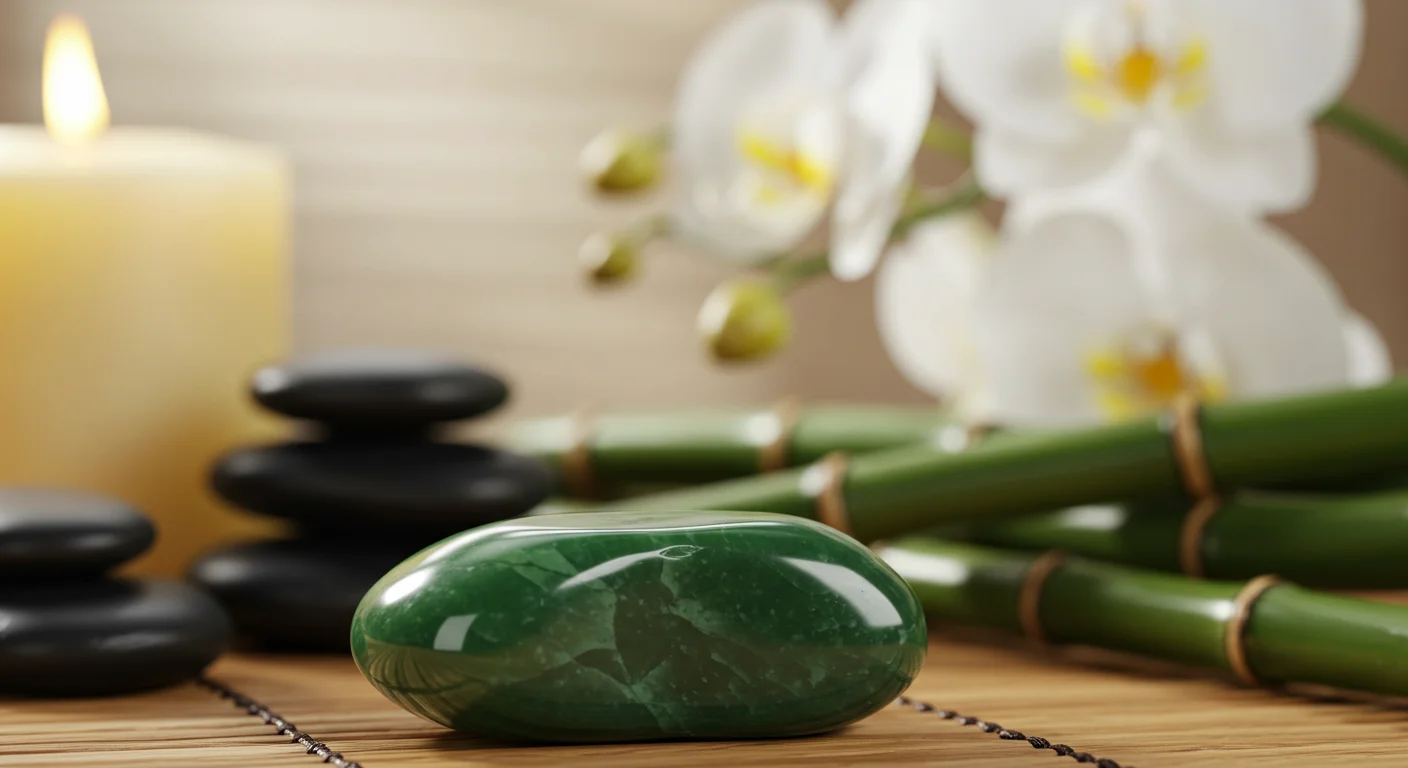Introduction: The Allure of Jadeite
Jadeitový kameň, or jadeite stone, has captivated human imagination for thousands of years. More than just a beautiful gemstone, it holds deep cultural, spiritual, and historical significance. Across continents — from ancient China to Central America — jadeite has been prized as a symbol of purity, protection, prosperity, and serenity. Its distinctive green hues, smooth texture, and mystical reputation have made it one of the most revered stones in both art and spirituality.
But what is it about jadeit that inspires such fascination? Is it the way light dances through its translucent surface, or is it the legends of its power to calm the mind and heal the body? In this article, we’ll explore the origin, meaning, and multifaceted influence of jadeitový kameň — uncovering the science, culture, and symbolism behind this enchanting gem.
The Origins and Composition of Jadeite
Jadeite is a mineral from the pyroxene group and one of the two minerals commonly referred to as “jade” — the other being nephrite. Both are beautiful and durable, but jadeite is rarer and typically more valuable due to its finer grain and greater translucency.
Formed deep within the Earth’s crust under extreme pressure, jadeite’s structure is compact and interlocking, giving it exceptional toughness. It scores between 6 and 7 on the Mohs hardness scale, making it ideal for intricate carving. The most prized variety of jadeite, known as Imperial Jade, glows with an intense emerald-green color due to the presence of trace amounts of chromium.
Natural jadeite can also appear in a range of shades — from pale lavender and milky white to vibrant green, yellow, and even blue-gray. Each variation is believed to carry its own energetic vibration and symbolic meaning.
Jadeite Through the Ages: A Historical Perspective
In Ancient China
In Chinese culture, jadeite was far more than a precious stone — it was considered the “Stone of Heaven.” Ancient Chinese emperors used jade artifacts as symbols of moral integrity, wisdom, and immortality. Confucius himself praised jade for its virtues, linking it to benevolence, justice, loyalty, and truth.
Jadeite ornaments, seals, and burial suits were used by royalty as protection in both life and death. The Chinese phrase “yu” (玉) came to mean not just jade, but preciousness itself.
In Mesoamerica
Meanwhile, on the other side of the world, the Maya and Aztec civilizations revered jadeite as the “stone of life.” It was associated with fertility, renewal, and the vital breath of the gods. They believed jadeite could connect humans with divine forces, and it was used to adorn kings, priests, and sacred idols.
Artifacts discovered in Guatemala and Mexico reveal jadeite masks, beads, and ceremonial blades, all symbolizing the continuity between the physical and spiritual worlds.
In Modern Times
Today, jadeite continues to enchant jewelers, collectors, and spiritual enthusiasts alike. Its cultural heritage endures in regions like Myanmar (Burma), where some of the world’s finest jadeite is still mined. Beyond aesthetics, many still wear jadeite for protection, emotional balance, and good fortune.
Symbolism and Meaning of Jadeitový Kameň
Jadeite has long been associated with balance, peace, and renewal. Its tranquil energy is said to align the body and spirit, helping to restore inner harmony. Let’s explore its deeper symbolic meanings:
- Harmony and Balance
Jadeite embodies equilibrium. Its soothing vibrations are thought to balance yin and yang energies, harmonizing the emotional and physical body. - Wisdom and Insight
Many spiritual traditions connect jadeite with the heart and third-eye chakras, enhancing intuition and compassion while promoting mental clarity. - Protection and Luck
Jadeite is believed to act as a spiritual shield, warding off negative energy and attracting prosperity. It’s a common talisman in Feng Shui, placed in homes to invite peace and abundance. - Healing and Renewal
The stone symbolizes growth and regeneration, encouraging self-acceptance and emotional healing. It reminds its wearer to let go of resentment and open the heart to forgiveness.
Physical and Metaphysical Properties
Physical Attributes
- Chemical composition: NaAlSi₂O₆ (sodium aluminum silicate)
- Crystal system: Monoclinic
- Hardness: 6.5–7 Mohs
- Luster: Vitreous to waxy
- Transparency: Translucent to opaque
These properties make jadeite both durable and visually appealing, perfect for sculptures, jewelry, and ornamental pieces.
Metaphysical Attributes
While science doesn’t confirm metaphysical effects, crystal healing traditions describe jadeite as having these influences:
- Calming the nervous system: Its cool energy is said to soothe the mind and alleviate anxiety.
- Supporting detoxification: Some believe jadeite aids the kidneys and liver, helping cleanse the body of impurities.
- Enhancing emotional stability: It promotes patience, wisdom, and self-reflection.
- Encouraging dream clarity: Used under the pillow, jadeite is thought to inspire meaningful dreams.
Even if these effects are symbolic, the psychological benefit of holding a belief in calm and focus cannot be denied.
Jadeite in Art, Jewelry, and Design
Jadeite’s beauty transcends fashion trends. From ancient sculptures to modern jewelry, it remains a cornerstone of artistic expression.
Carving and Sculpture
Because jadeite is tough yet workable, artisans have long cherished it for intricate carvings — from figurines and dragons to ceremonial vessels. Each piece tells a story of devotion and craftsmanship.
Jewelry
Jadeite’s luminous greens make it a favorite for necklaces, bangles, and earrings. In East Asian cultures, jade bracelets are often gifted to signify protection and good fortune. The stone’s durability means it can be worn daily, gradually absorbing the wearer’s energy and forming a symbolic bond.
Modern Design
Today, designers experiment with jadeite in minimalist home décor — embedding it in furniture, lighting, or even skincare tools like jade rollers used for facial massage. This modern adaptation blends aesthetics with well-being.
Cultural Beliefs and Healing Practices
Across many traditions, jadeite is a stone of purification. Here are some of the ways it’s incorporated into holistic practices:
- Feng Shui Applications
Jadeite is considered a powerful harmonizer of spaces. Placing it in the eastern area of a home (associated with family and health) is believed to promote vitality and peace. - Meditation and Chakra Healing
When used during meditation, jadeite helps to ground emotional energy. It is linked primarily to the heart chakra, encouraging love, empathy, and acceptance. - Spiritual Talismans
Many carry small jadeite stones as personal amulets. It’s said to absorb negativity and replace it with gentle, stabilizing energy. - Skincare and Relaxation
Jadeite rollers and gua sha tools have gained popularity for their cooling, soothing effect on the skin, though much of this benefit comes from temperature and massage rather than mineral energy.
Scientific Perspective: The Reality Behind the Belief
While cultural traditions speak of jadeite’s healing powers, scientific research doesn’t support direct physical health benefits from crystals. However, there’s an undeniable psychological component — the so-called placebo effect.
When individuals associate jadeite with calmness and self-care, their stress levels may indeed decrease. Rituals like meditation or using jade tools encourage mindfulness, which itself has proven health benefits.
Thus, jadeite’s true “power” may lie not in its molecular structure, but in the mindset it helps create — a sense of peace, confidence, and intention.
How to Care for and Clean Jadeite
To preserve jadeite’s luster and energy, careful maintenance is key:
- Cleaning: Use mild soap, lukewarm water, and a soft cloth. Avoid harsh chemicals or ultrasonic cleaners.
- Storage: Keep it separate from harder gemstones to prevent scratching.
- Recharging: In crystal healing practices, jadeite is “cleansed” by placing it under moonlight or rinsing it with clean water to refresh its energy.
- Avoid Heat: Prolonged exposure to heat or sunlight can cause color fading, especially in treated stones.
How to Identify Authentic Jadeite
The market is filled with imitations and treated stones, so identifying genuine jadeite is essential. Here’s what to look for:
- Density and Feel: Jadeite feels heavier and cooler than most fakes.
- Sound Test: When tapped lightly, real jade produces a soft, resonant tone.
- Magnification: Under a loupe, genuine jadeite shows interlocking fibrous structures, not bubbles or cracks typical of glass.
- Certification: Always purchase from reputable dealers who provide gemological certificates verifying authenticity.
High-quality jadeite can be quite expensive, especially the “Imperial Jade” variety, which rivals diamonds in value.
Emotional and Psychological Benefits
Beyond physical appearance, jadeitový kameň resonates deeply with human emotions. Its gentle green hues evoke nature, renewal, and serenity — all vital for emotional well-being.
Many believe it helps release suppressed feelings and cultivates compassion. Wearing jadeite can serve as a tangible reminder to stay centered and kind, making it not just a gemstone but a spiritual companion in daily life.
Jadeite and Modern Sustainability
In today’s world, ethical sourcing is crucial. Some jadeite mining practices, especially in Myanmar, have raised environmental and human-rights concerns. Responsible buyers now seek ethically mined or recycled jadeite, ensuring that beauty doesn’t come at the cost of exploitation.
Supporting sustainable jewelers helps preserve both nature and the cultural legacy of jadeite craftsmanship for future generations.
Conclusion
Jadeitový kameň is more than a jewel — it is a bridge between worlds: art and nature, science and spirit, body and soul. Whether you wear it for its beauty, meditate with it for inner calm, or cherish it as a symbol of luck and protection, jadeite’s enduring charm lies in its timeless balance.
While science may not confirm its mystical healing powers, the peace and intention it inspires are very real. After all, sometimes what truly matters isn’t the stone’s chemistry but the sense of harmony it brings to our hearts and minds.
So next time you hold a jadeite stone, remember — you’re holding centuries of wisdom, craftsmanship, and belief in the quiet power of serenity.
FAQs
1. What is the main difference between jadeite and nephrite?
Jadeite is rarer, harder, and comes in a wider range of colors than nephrite, which is generally softer and more common.
2. Does jadeite really have healing powers?
There’s no scientific proof of physical healing effects, but many people find jadeite soothing and use it for meditation and emotional balance.
3. How can I tell if my jadeite is real?
Look for a smooth, cool feel, natural translucency, and a soft ringing sound when tapped. Certified gem reports provide the most reliable confirmation.
4. Can jadeite lose its color over time?
Natural jadeite maintains its color with proper care, but dyed or treated stones can fade if exposed to heat or sunlight.
5. Is jadeite suitable for daily wear?
Yes. Jadeite’s durability makes it perfect for daily jewelry, though it should still be protected from hard impacts and harsh chemicals.

